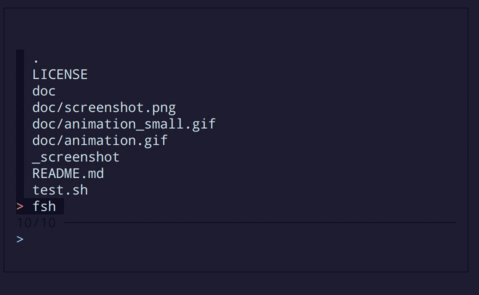|
Minimalist selector in shell, à la fzf You need to:
Just copy the fsh function in your script. |
$ echo -e 'Hello, world!\n¡Hola, mundo!\nBonjour, le monde !\nHallo, Welt!' | ./fsh...
Hello, world!
¡Hola, mundo!
Bonjour, le monde !
Hallo, Welt!
>
type your text
Hallo, Welt!
> hall
Press enter
Hallo, Welt!
- not POSIX shell: it's only tested in
zshandbash. - to keep it lightweight and fast, I (mostly) don't plan on adding new features.
You can customize the behavior of fsh by setting the following variables:
| Variable | Description | Default value |
|---|---|---|
| FSH_SELECTOR_COLOR | the color line currently highlighted | 40 |
| FSH_FRAME_COLOR | the color of the frame | 30 |
| FSH_PROMPT_COLOR | the color used for the prompt | 34 |
| FSH_SELECT_COLOR | the color of the sign before the line currently selected | 31 |
| FSH_TEST_INPUT | the simulated user input given as a string, one character at a time. first character will be ignored. if set the script will not read from stdin | "" |
| FSH_HEADER | a name to display beofre the prompt to give context on what is expected | "" |
| FSH_VIM_MODE | (not implemented) set this variable to support vim normal mode | "" |
| FSH_PERF | if this variable is set, will display the time it took to draw the interface | "" |
| FSH_NO_FUZZY | if this variable is set, will not use fuzzy search, instead will do a pattern match | "" |
| FSH_SCREENSHOT | if this variable is set, will write a screenshot of the terminal at each iteration and generate an animation at the end | "" |
